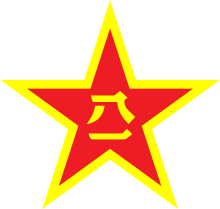71st Group Army
This article needs additional citations for verification. (December 2010) |
| 71st Group Army | |||||
|---|---|---|---|---|---|
 | |||||
| Active | 1949– | ||||
| Country | |||||
| Allegiance | |||||
| Type | Field army Group army | ||||
| Part of | Eastern Theater Command Ground Force | ||||
| Garrison/HQ | Heping Road in the Yunlong District of Xuzhou in Jiangsu Province | ||||
| Colors | Red and Green | ||||
| March | "The March of the Chinese People's Liberation Army" | ||||
| Engagements | Second Sino-Japanese War Chinese Civil War Korean War(Battle of Triangle Hill) | ||||
| Commanders | |||||
| Current commander |
| ||||
| Political Commissar | Major General | ||||
| Notable commanders | Wang Jinshan You Taizhong Li Desheng Li Zhen Zeng Shaoshan Ma Ning | ||||
| Insignia | |||||
| NATO Map Symbol |
| ||||
The 71st Group Army, formerly the 12th (Group) Army, was one of the three group armies of the Chinese People's Liberation Army's Eastern Theater Command (formerly Nanjing Military Region).[1]
It was disbanded and redesignated in mid 2017 as the 71st Group Army.[2]
History[]
Second World War[]
In 1932, the 25th Red Army
The origin of the 12th Army lies in the surrender of the 74th Division of the Chinese Nationalist National Revolutionary Army, as well as with the sixth column of the Second Field Army.
Chinese Civil War[]
On 9 February 1949, the 34th, 35th and the were incorporated into the Twelfth Army.[3] On 29 November 1949, Chongqing was captured and later the Battle of Chengdu was fought.[4]
Korean War[]
In December 1950, the 12th Army entered the Korean War. The of the 11th Army was incorporated into the 12th Army. The 11th Army returned to China in 1954.[citation needed]
Late-20th century[]
From 1 August 1983, the 2nd Tank Division was attached to the 12th Army Corps.[5]
In 1985, the 12th Army was re-formed as a Group Army. It was incorporated into the "60 June 179" division. The re-organization also involved the 2nd Tank Division and an artillery brigade.[citation needed]
In May 1989, the 12th Army's 34th, 36th and 110th Divisions, Artillery Brigade, and Anti-Aircraft Battalion were deployed to Beijing to enforce martial law and suppress the Tiananmen Square protests of 1989.[6]
In 1998, the first 34th division of the 12th Army was re-deployed as a motorised infantry brigade (divorced from the 2nd tank division). The 35th division was moved to the Jiangsu military region. At a later stage, the 36th and the 179th divisions were motorised.[citation needed]
In 2002 Blasko wrote that the army comprised the:[7]
- , east Anhui
- 179th Motorized Infantry Brigade (People's Republic of China) ("Linfen Brigade") (83123 Unit) Nanjing, Jiangsu
- an unidentified motorized infantry brigade
- 2nd Armored Division (People's Republic of China) (83567 Unit) Xuzhou, Jiangsu
- Artillery Brigade
- Anti-Aircraft Artillery Brigade
The army was disbanded in 2017 and replaced by the new 71st Group Army.[citation needed]
References[]
- ^ Staff (2000–2012). "Nanjing Military Region Nanjing Military Area Command". GlobalSecurity.org. Retrieved 4 June 2012.
- ^ "PLA Orbat reform update (Jun 2017)". china-defense.blogspot.co.nz. Retrieved 18 July 2017.
- ^ In accordance with the Regulation of the Redesignations of All Organizations and Units of the Army, issued by Central Military Commission on 1 November 1948.
- ^ Sohu (2 November 2005). 军旅采风. laobing.com (in Chinese). laobing.com, Yingpu. Retrieved 4 June 2012.
- ^ 坦克第2师历史,http://blog.sina.com.cn/s/blog_4990f3180100ylwa.html Archived 25 August 2016 at the Wayback Machine
- ^ Based on Wu Renhua's study. (Chinese)Wu Renhua, "进京的戒严部队和进京路线" 《1989天安门事件二十周年祭》系列之十二 Accessed 29 June 2013
- ^ Dennis J. Blasko. "PLA Ground Forces: Moving Toward a Smaller, More Rapidly Deployable, Modern Combined Arms Force" The People's Liberation Army as Organization: Reference Volume v1.0, James C. Mulvenon and Andrew N. D. Yang eds. (Santa Monico: RAND; 2002), 334.
- Field armies of the People's Liberation Army
- Eastern Theater Command
- Nanjing Military Region
- Military units and formations established in 1949
